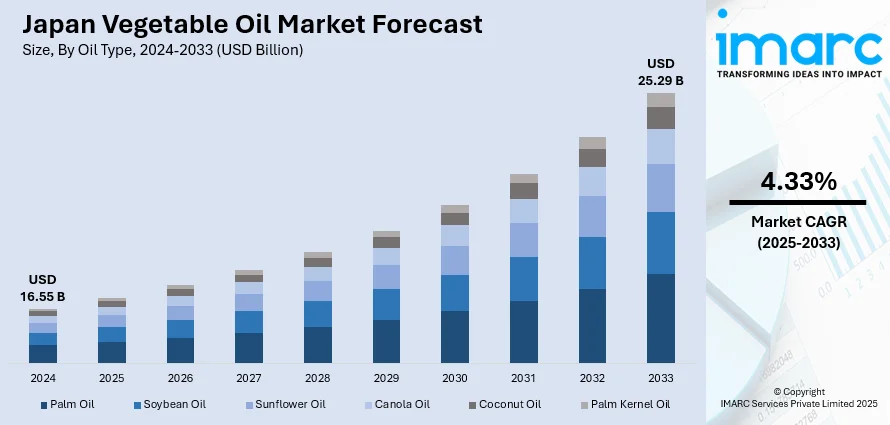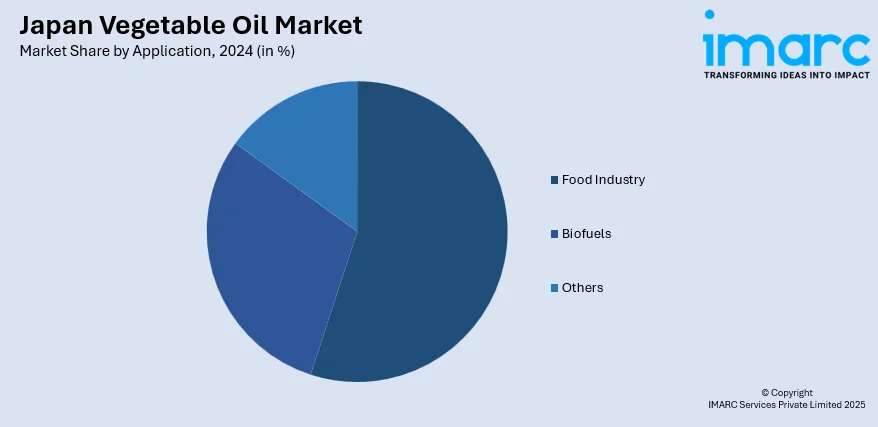
Japan Vegetable Oil Market Size, Share, Trends and Forecast by Oil Type, Application, and Region, 2025-2033
Japan Vegetable Oil Market Overview:
The Japan vegetable oil market size reached USD 16.55 Billion in 2024. Looking forward, the market is projected to reach USD 25.29 Billion by 2033, exhibiting a growth rate (CAGR) of 4.33% during 2025-2033. The market is driven by rising product demand in processed foods and institutional catering, supported by long-standing procurement frameworks. Functional oil varieties and health-driven reformulation are reshaping consumer preferences. Additionally, circular processing innovations and industrial uses across bioplastics, cosmetics, and fuel recovery are further augmenting the Japan vegetable oil market share.
|
Report Attribute
|
Key Statistics
|
|---|---|
|
Base Year
|
2024 |
|
Forecast Years
|
2025-2033
|
|
Historical Years
|
2019-2024
|
| Market Size in 2024 | USD 16.55 Billion |
| Market Forecast in 2033 | USD 25.29 Billion |
| Market Growth Rate 2025-2033 | 4.33% |
Japan Vegetable Oil Market Trends:
Health-Conscious Reformulation and Functional Oil Demand
In response to heightened consumer awareness around metabolic health, food companies in Japan are reformulating products to reduce saturated fat and introduce functional lipids. High-oleic canola oil, rice bran oil, and oils rich in omega-3 and tocotrienols are being promoted for their health benefits. Major edible oil brands have developed healthy sub-lines focused on cholesterol-lowering properties, light absorption during frying, and antioxidant enrichment. Additionally, the Ministry of Health, Labour and Welfare encourages fortification and functional food labeling under Japan’s Foods with Function Claims (FFC) system, which has led to a rise in healthy oil branding. Premium segments of the market—particularly in urban centers—favor cold-pressed, unrefined, and organic vegetable oils, used both for cooking and in cosmetic or nutraceutical applications. This trend aligns with Japan’s high consumer trust in food safety, traceability, and clinical validation. On January 17, 2024, Japan confirmed that it will enforce national labelling regulations for extra virgin olive oil (EVOO) from March 2024, fully aligned with the International Olive Council (IOC) trade standard. Olive oil is currently the highest-value vegetable oil in Japan, and the country has now established 5 IOC-recognized physico-chemical laboratories and two certified sensory panels, up from zero in 2017. This regulatory advancement reinforces quality assurance in Japan’s premium edible oil segment. Retailers and e-commerce platforms are leveraging this by offering detailed origin information, composition breakdowns, and usage recommendations. Long-standing consumption habits, food industry quality demands, and robust procurement frameworks are integral components sustaining Japan vegetable oil market growth within its mature, urbanized economy.

To get more information on this market, Request Sample
Stable Demand in Processed Foods and Institutional Catering
Japan’s vegetable oil market benefits from a consistent demand base across the processed food, convenience meal, and institutional catering segments. With a large aging population and a busy urban workforce, ready-to-eat meals, bento boxes, and fried snacks form a cornerstone of national consumption habits. Major food processors and restaurant chains rely on vegetable oils, especially canola, soybean, and palm, for frying, emulsification, and preservation. Japan’s strict food quality regulations encourage stable, high-grade oil supply across manufacturing, school lunch programs, and hospital food services. The foodservice sector emphasizes refined, low-smoke-point oils to support operational hygiene and flavor retention. Moreover, despite health trends, fried foods such as tempura, karaage, and tonkatsu remain culturally embedded. As domestic oilseed production is limited, Japanese refiners and importers maintain long-term contracts with suppliers in Canada, the US, and Southeast Asia. These institutionalized purchasing structures reduce volatility in procurement and stabilize pricing over time. Long-standing consumption habits, food industry quality demands, and robust procurement frameworks are integral components sustaining market growth.
Japan Vegetable Oil Market Segmentation:
IMARC Group provides an analysis of the key trends in each segment of the market, along with forecasts at the country and regional levels for 2025-2033. Our report has categorized the market based on oil type and application.
Oil Type Insights:
- Palm Oil
- Soybean Oil
- Sunflower Oil
- Canola Oil
- Coconut Oil
- Palm Kernel Oil
The report has provided a detailed breakup and analysis of the market based on the oil type. This includes palm oil, soybean oil, sunflower oil, canola oil, coconut oil, and palm kernel oil.
Application Insights:

- Food Industry
- Biofuels
- Others
The report has provided a detailed breakup and analysis of the market based on the application. This includes food industry, biofuels, and others.
Regional Insights:
- Kanto Region
- Kansai/Kinki Region
- Central/Chubu Region
- Kyushu-Okinawa Region
- Tohoku Region
- Chugoku Region
- Hokkaido Region
- Shikoku Region
The report has also provided a comprehensive analysis of all major regional markets. This includes Kanto Region, Kansai/Kinki Region, Central/Chubu Region, Kyushu-Okinawa Region, Tohoku Region, Chugoku Region, Hokkaido Region, and Shikoku Region.
Competitive Landscape:
The market research report has also provided a comprehensive analysis of the competitive landscape. Competitive analysis such as market structure, key player positioning, top winning strategies, competitive dashboard, and company evaluation quadrant has been covered in the report. Also, detailed profiles of all major companies have been provided.
Japan Vegetable Oil Market Report Coverage:
| Report Features | Details |
|---|---|
| Base Year of the Analysis | 2024 |
| Historical Period | 2019-2024 |
| Forecast Period | 2025-2033 |
| Units | Billion USD |
| Scope of the Report | Exploration of Historical Trends and Market Outlook, Industry Catalysts and Challenges, Segment-Wise Historical and Future Market Assessment:
|
| Oil Types Covered | Palm Oil, Soybean Oil, Sunflower Oil, Canola Oil, Coconut Oil, Palm Kernel Oil |
| Applications Covered | Food Industry, Biofuels, Others |
| Regions Covered | Kanto Region, Kansai/Kinki Region, Central/Chubu Region, Kyushu-Okinawa Region, Tohoku Region, Chugoku Region, Hokkaido Region, Shikoku Region |
| Customization Scope | 10% Free Customization |
| Post-Sale Analyst Support | 10-12 Weeks |
| Delivery Format | PDF and Excel through Email (We can also provide the editable version of the report in PPT/Word format on special request) |
Key Questions Answered in This Report:
- How has the Japan vegetable oil market performed so far and how will it perform in the coming years?
- What is the breakup of the Japan vegetable oil market on the basis of oil type?
- What is the breakup of the Japan vegetable oil market on the basis of application?
- What is the breakup of the Japan vegetable oil market on the basis of region?
- What are the various stages in the value chain of the Japan vegetable oil market?
- What are the key driving factors and challenges in the Japan vegetable oil market?
- What is the structure of the Japan vegetable oil market and who are the key players?
- What is the degree of competition in the Japan vegetable oil market?
Key Benefits for Stakeholders:
- IMARC’s industry report offers a comprehensive quantitative analysis of various market segments, historical and current market trends, market forecasts, and dynamics of the Japan vegetable oil market from 2019-2033.
- The research report provides the latest information on the market drivers, challenges, and opportunities in the Japan vegetable oil market.
- Porter's five forces analysis assist stakeholders in assessing the impact of new entrants, competitive rivalry, supplier power, buyer power, and the threat of substitution. It helps stakeholders to analyze the level of competition within the Japan vegetable oil industry and its attractiveness.
- Competitive landscape allows stakeholders to understand their competitive environment and provides an insight into the current positions of key players in the market.
Need more help?
- Speak to our experienced analysts for insights on the current market scenarios.
- Include additional segments and countries to customize the report as per your requirement.
- Gain an unparalleled competitive advantage in your domain by understanding how to utilize the report and positively impacting your operations and revenue.
- For further assistance, please connect with our analysts.
 Request Customization
Request Customization
 Speak to an Analyst
Speak to an Analyst
 Request Brochure
Request Brochure
 Inquire Before Buying
Inquire Before Buying




.webp)




.webp)












